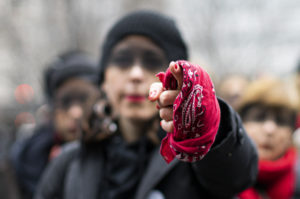During the 2017 peak of the #MeToo movement, the conversation about sexual harassment came down to two related but ultimately separate questions. On the one hand, there was the question of what men shouldn’t do; on the other, there was the question of what women could be expected to tolerate.
This was where some women, usually but not always older, rolled their eyes. Did an awkward joke, a bad date, or — as one memorable entry in the infamous Shitty Media Men list alleged — a “weird lunch” really constitute a form of harassment, let alone a cancellable offence? But other women, usually but not always younger, clucked their tongues: it was only because women kept putting up with such behaviour that men kept thinking they could get away with it.
At the time, the younger cohort appeared to the older like a bunch of hypersensitive harpies, retreating to the fainting couch at the slightest whiff of insult. The older, according to the younger, were cosying up to the patriarchy, in a desperate attempt to stave off their own irrelevance.
“We’re tough enough to take it,” said the Olds.
“It’s sad you think you have to,” said the Youths.
This early rift in the movement represented a deeper philosophical disagreement, about the nature and importance of resilience. The narrow question is, when does an annoying man becomes an evil harasser? The broader one is, when does a tolerable nuisance cross the line to become an intolerable transgression?
This question has been on my mind this week, for the most tragic of reasons. On 1st May, a 30-year-old man named Jordan Neely was choked to death on a crowded New York City subway train by a 24-year-old Marine named Daniel Penny. Neely, who was homeless and mentally ill, was reportedly screaming and confronting passengers; he was killed after Penny put him in a chokehold, while two other passengers held him down. Penny, in a statement released through his lawyers, said he did not intend to kill Neely.
This incident was preventable. Long before his death, Neely was known to New York City authorities as a person who could not manage independent living, and who had been spiralling in recent years, desperately in need of help. For him to die on the dirty floor of a subway car, screaming and defecating on himself while three strangers held him by the arms, legs, and neck, he had to be first failed at every turn by a system that was supposed to shelter and protect him — not just from doing harm, but from being harmed by others when his mental illness manifested in frightening ways.
That Neely slipped through the cracks is not the only sign of institutional failure here. As ridership on the NYC subway has increased in the wake of Covid, so too have instances of violence, including several high-profile incidents in which people have been attacked or killed. New York City mayor Eric Adams was elected in 2021 on a campaign that promised to flood the subway system with uniformed police officers, to combat both crime and the perception that the subway has become wildly more dangerous in recent years.
To what extent this campaign could succeed is not clear. There has always been a baseline level of criminality and antisocial behaviour on the subway; sexual harassment and assault is so ubiquitous that brushing up against it is all but inevitable. I was groped, flashed, or masturbated at probably two dozen times during the seven years I spent living in New York. When a friend moved to NYC last year, I told her that she couldn’t truly call herself a New Yorker until she exited a crowded subway car to discover that someone had ejaculated on her coat. (I was only partly kidding.) It’s not that anyone thinks these things are okay; it’s more that they’re expected, a sad fact of life in a city of 8.5 million people, one of those things you cannot change and hence have to find a way to put up with. You look away, you shrug it off, you don’t let it ruin your day because if you did, it would ruin all of your days.
Here is where the notion of resilience enters in. New York City residents have perhaps a higher tolerance than most for antisocial behaviour in public places, on the subway in particular. Warm and dry, with a captive audience, it attracts all kinds of colourful personalities: panhandlers and performers, pickpockets and preachers, as well as people like Neely who are in the grips of something darker. Until recently, it was standard practice to meet the arrival of one of these people on a crowded carriage with downcast eyes and silence; there was a tacit agreement that you neither react to nor acknowledge the transgressor. That agreement remained in place as crime rose, and as NYC saw a marked increase in behaviour that, even if it started out as merely weird, could — and did — escalate rapidly to violence. In 2022, for instance, a video did the rounds, of a woman begging for help while a deranged man hauls her around a train car by her hair.
But if it was difficult to know exactly where a tolerance for breaches of decorum became apologia for criminal harassment, it was even harder to identify, after Jordan Neely’s death, where the tacit agreement to tolerate becomes a duty to intervene. How do we know when to stand by, when to step in, when to look away, when to be afraid?
Here, one might have expected that many of the same voices who argued so vehemently against the notion of resilience in the midst of MeToo — the ones who believed that the solution to harassment lay not in teaching women to be assertive, but in teaching men not to abuse — would now demand zero tolerance for male aggression on public transit. If you argue that a woman can be traumatised by bawdy humour in the office or awkward come-ons in a bar, surely you would agree that she’s entitled to be fearful when trapped underground on a metal tube with an erratically-behaving stranger twice her size.
But, no: instead, many of the people who once insisted that men who slid into DMs deserved the complete destruction of their professional reputations became passionate advocates for toughening up when it came to dealing with volatile people on public transit. Coverage and commentary from the Left downplayed the possibility that Neely’s behaviour was frightening; instead, he was “acting erratic“, or “houseless and crying for food“. One viral tweet suggested that tragedy could have been averted with “a dollar and granola bar”. The New York Times guide to navigating similar scenarios on public transit took it a step further, imagining someone like Neely as a wild animal it is everyone else’s duty not to provoke: “Don’t make eye contact — especially prolonged eye contact, which might be perceived as threatening.”
Meanwhile, threads proliferated mocking the notion that New York’s subways might be a dangerous place: “I’ve safely ridden the subway for 23 years and my child has never been menaced by a half naked lunatic, but these imaginary monsters in your head are addressable with therapy,” wrote Elizabeth Spiers, a founding editor of Gawker and journalism professor at NYU. This is a remarkable sentiment, and not just because of its stunning reversal of the MeToo-era catechism that allegations should be believed. Less than a year ago, Spiers was among those advocating for the suspension without pay of journalist Dave Weigel after he retweeted what some perceived as a sexist joke, owing to the way this was allegedly received by his female colleagues (“[Every] woman who works with you thinks you’ve telegraphed publicly that you don’t respect women.”)
To sum up: a man who reposts an off-colour joke is advertising his innate misogyny, to the point where women should feel uncomfortable sharing a workplace with him. But an agitated and clearly unstable man announcing to a crowded subway car — as Neely reportedly did — that he’s been pushed to the brink and is ready to die, or go to prison for life: why in the world would you find that menacing?
This sudden rediscovery of the merits of resilience would have been almost refreshing, if not for the whiplash of its promotion by people who up until very recently were arguing that a tweet made them unsafe. There’s even something to it: the ubiquity of certain kinds of boundary-challenging behaviour in big cities makes it not just impractical but impossible to treat every incident of one-off harassment from a stranger as if it’s the end of the world. And of course, once you’ve survived a run-in with the mystery subway ejaculator, sexist microaggressions are unlikely to faze you: cultivating resilience is how we learn to recognise that a situation can be both genuinely alarming but not materially unsafe, or to make peace with the fact that many things which make us uncomfortable should nevertheless be allowed.
But this mindset was considered anathema during MeToo. With trauma allegedly lurking just around the corner of every heterosexual encounter, distrust became the default. Not just the default, but celebrated — “men need to feel a cold spike of fear when they begin a sexual encounter,” intoned Vox‘s Ezra Klein, in a proto-MeToo celebration of this new, terrified paradigm for intimacy. The idea, of course, was that women already felt that fear, living as they did at the eternal precipice of victimisation by the patriarchy; in a truly equal society, everyone would be scared.
Of course, today’s 180-degree pivot to brash fearlessness is identitarian horse-trading: MeToo is out, BLM is in. The dynamics of any conflict must be considered along these lines, and the narrative must be massaged accordingly. This was true in 2020 when a white woman called the police on a black man who threatened her in a public park; it is true now, as piety demands that the behaviour of the black, homeless victim of this terrible tragedy must not be scrutinised in any way. On the Left, that is; the Right has spent the past few days waving Neely’s criminal history in the air, singing “He Had It Coming”, in an absolute spectacle of ghoulishness.
In the end, neither the malicious glee from the Right nor the aggressive minimisation from the Left are treating this case with the sensitivity it deserves. The truth is, eyewitnesses did report that Neely was behaving in a threatening way, and other people on the train were calling 911 well before his confrontation with Penny, suggesting that whatever was happening, it was a cut above the ordinary subway madness that New Yorkers are usually so good at ignoring. But it is also true that the tragic conclusion of this incident seems, at least in part, like the result of a cultivated fragility — the kind that results when you encourage people to view every uncomfortable situation as a trauma in the making, every unpleasant interaction as a precursor to a far worse harm, every upset as an offence for which there must be consequences. That mindset, so ubiquitous in the wake of MeToo, so popular among progressives in general, says that no breach of decorum or moment of discomfort is too insignificant to ignore. It must be registered. It must be punished. It’s nothing more or less than a call for constant vigilance. The thing about that: when you demand vigilance, you get vigilantes.
Disclaimer
Some of the posts we share are controversial and we do not necessarily agree with them in the whole extend. Sometimes we agree with the content or part of it but we do not agree with the narration or language. Nevertheless we find them somehow interesting, valuable and/or informative or we share them, because we strongly believe in freedom of speech, free press and journalism. We strongly encourage you to have a critical approach to all the content, do your own research and analysis to build your own opinion.
We would be glad to have your feedback.
Source: UnHerd Read the original article here: https://unherd.com/




